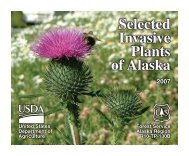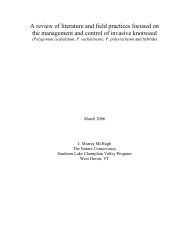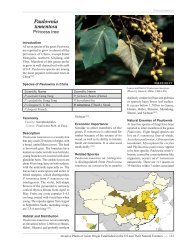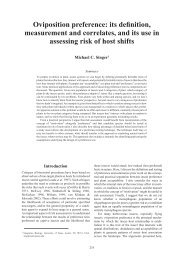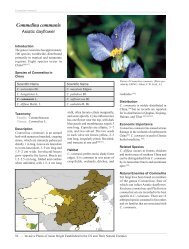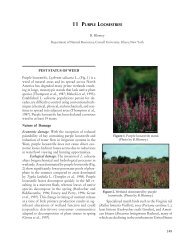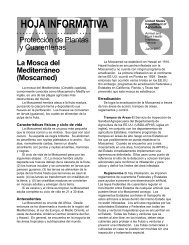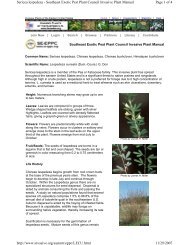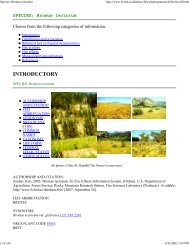The Biology of Tectococcus ovatus Hempel ... - Invasive.org
The Biology of Tectococcus ovatus Hempel ... - Invasive.org
The Biology of Tectococcus ovatus Hempel ... - Invasive.org
Create successful ePaper yourself
Turn your PDF publications into a flip-book with our unique Google optimized e-Paper software.
652<br />
Vitorino et al.<br />
Eriococcidae) was readily manipulated in the laboratory. This coccid appeared to satisfy<br />
the immediate criterion that it attack P. cattleianum and not P. guajava because galls were<br />
not found on latter when the two plants were growing together. It was consequently<br />
believed to attack only the target <strong>org</strong>anism, as is true for other species <strong>of</strong> this group<br />
(COSTA LIMA, 1942). This paper describes the biology <strong>of</strong> this insect, some preliminary<br />
experiments detailing its host specificity and concludes that this species is a biological<br />
control candidate <strong>of</strong> considerable potential against strawberry guava in Hawaii and elsewhere<br />
in the world where this weed is a problem.<br />
Material and Methods<br />
Collections were made in three municipal districts (Piraquara, São José dos Pinhais<br />
and Colombo) <strong>of</strong> the metropolitan area <strong>of</strong> Curitiba, Paraná, Brazil, located on the first<br />
plateau between 650 and 1.100 m. <strong>The</strong> vegetation is cloud forest with a submontane climate,<br />
annual mean temperature between 15-19° C, minimum between -5 to -10° C, with<br />
up to 40 frosts/year. <strong>The</strong> annual mean precipitation varies between 1,250-2,500 mm uniformly<br />
distributed throughout the year with no droughts (CARPANEZZI, 1986).<br />
Collections <strong>of</strong> galls were made monthly to determine the life history, annual cycle <strong>of</strong><br />
the species, and its associated parasitoids and predators. Leaves with all stages <strong>of</strong> gall<br />
development were studied including those with galls that had fallen to the ground. Leaves<br />
were stored in entomological bottles (5 x 10 cm) covered with gauze to capture parasitoids<br />
or predators that might emerge from the galls. Leaves with galls were maintained for<br />
observation in Petri plates over humidified filter paper at 22 ± 2° C at 12 hours photoperiod.<br />
<strong>The</strong> maximum and minimum diameters <strong>of</strong> the galls on both the acuminate and convex<br />
sides as well as the depth <strong>of</strong> the gall were measured. <strong>The</strong> median diameters were then clas-<br />
Table 01.<br />
Classes <strong>of</strong> mean diameters and length <strong>of</strong> galls <strong>of</strong> <strong>Tectococcus</strong> <strong>ovatus</strong>.<br />
CLASS (mm) MEAN NUMBER %<br />
MEAN DIAMETER – ACUMINATE SIDE<br />
0 - 2,4913 (I) 1,1393 22 16,18<br />
2,4914 - 5,1954 (II) 3,8434 90 66,18<br />
5,1955 - 7,8995 (III) 6,5475 24 17,64<br />
TOTAL 136 100,00<br />
MEAN DIAMETER – CONVEX SIDE<br />
0,2755 - 2,9985 (I) 1,6370 23 16,91<br />
2,9986 - 5,7216 (II) 4,3601 87 63,97<br />
5,7217 - 8,4447 (III) 7,0832 26 19,12<br />
TOTAL 136 100,00<br />
LENGTH<br />
0,0235 - 2,9264 (I) 1,4750 18 13,44<br />
2,9265 - 5,8295 (II) 4,3780 93 69,40<br />
5,8296 - 8,7326 (III) 7,2811 23 17,16<br />
TOTAL 134 100,00


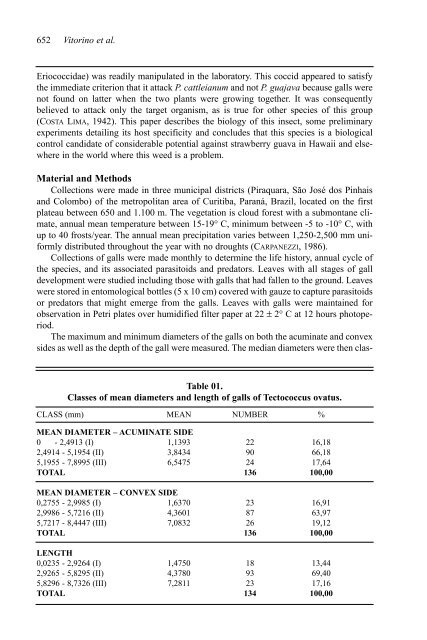

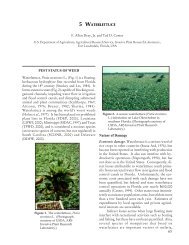

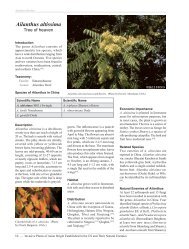
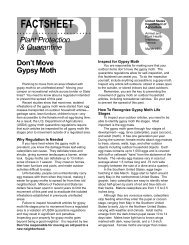
![A Guide to the Control and Management of Invasive Phragmites [PDF]](https://img.yumpu.com/27321025/1/190x190/a-guide-to-the-control-and-management-of-invasive-phragmites-pdf.jpg?quality=85)
